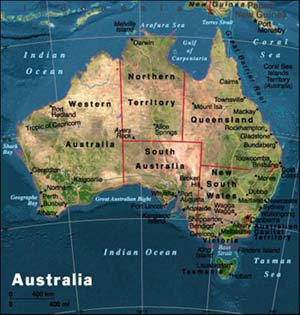Travel Diary:
I spent in Australia about 20 month – from end of April 2004 to beginning of January 2006. During my stay I lived in Sydney, the biggest Australian City. The best of Australia is in its natural beauty. I was lucky enough to travel through most of parts of Australia and it would be very difficult to pick just one place that I loved the most, so here is my Top Ten:
1.Kakadu National Park, NT
2. Great Barrier Reef, QLD
3. Whitsunday’s, QLD
4. Katherine George, NT
5. Ningaroo Reef, WA
6. Great Ocean Road, VIC
7. Fraser Island, QLD
8. Kangaroo Island, SA
9. Uluru, NT
10. Sydney, NSW
Geography:
Australia is the world's smallest continent but sixth-largest country; population is concentrated along the eastern and southeastern coasts.Australia consist of 6 states and 2 territories: Australian Capital Territory, New South Wales, Northern Territory, Queensland, South Australia, Tasmania, Victoria, Western Australia.
History:
Aboriginal settlers arrived on the continent from Southeast Asia about 40,000 years before the first Europeans began exploration in the 17th century. No formal territorial claims were made until 1770, when Capt. James COOK took possession in the name of Great Britain. Six colonies were created in the late 18th and 19th centuries; they federated and became the Commonwealth of Australia in 1901. The new country took advantage of its natural resources to rapidly develop agricultural and manufacturing industries and to make a major contribution to the British effort in World Wars I and II. In recent decades, Australia has transformed itself into an internationally competitive, advanced market economy. It boasted one of the OECD's fastest growing economies during the 1990s, a performance due in large part to economic reforms adopted in the 1980s. Long-term concerns include pollution, particularly depletion of the ozone layer, and management and conservation of coastal areas, especially the Great Barrier Reef.
Flag Description:
Blue with the flag of the UK in the upper hoist-side quadrant and a large seven-pointed star in the lower hoist-side quadrant known as the Commonwealth Star, representing the federation of the colonies of Australia in 1901; the star depicts one point for each of the six original states and one representing all of Australia's internal and external territories; the remaining half is a representation of the Southern Cross constellation in white with one small five-pointed star and four larger, seven-pointed stars.





